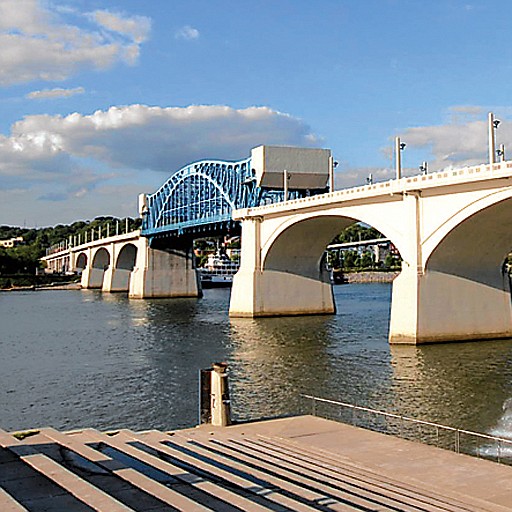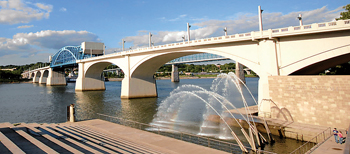Chattanooga's Market Street Bridge added to historic list
Saturday, February 12, 2011
The Market Street Bridge has a new designation.
The largest drawbridge of its type east of the Mississippi River was one of eight Tennessee sites added this week to the National Register of Historic Places, state officials announced Friday.
The 2,000-foot steel and concrete span opened across the Tennessee River in 1917 and today welds together Chattanooga's downtown waterfront with the city's revitalized North Shore.
Receiving the designation puts an exclamation point on the bridge's comeback story. Originally dubbed the "million-dollar bridge" after its much-delayed and overbudget construction, the bridge in 2005 made the state highway department's list as one of the state's most dilapidated.
In 2007, after a two-year, $13 million renovation by Britton Bridge Co., that listing was changed.
"It wouldn't be Chattanooga without the Market Street Bridge," said Jerry Britton, who led the remake.
His crews not only rebuilt crumbling supports and decking, they also replaced 1980s light fixtures with period ones and restored the original walkways and metal hand rails and balustrades.
"Look at the quality of the [original] workmanship," Britton said. "Go look at that hand rail. You don't find that in bridges today. I think it should be on the register."
Paul Archambault, historian for the Southeast Tennessee Development District, wrote the nomination for the bridge, formally known as the Chief John Ross Bridge.
"It represents a rare engineering marvel in the Southeast United States region. At 310 feet, the double-leaf steel bascule lift was the largest span of its kind in the world when the bridge opened for traffic," the nomination states. "The six concrete arches [also] made it the largest concrete bridge in the South at that time."
Tennessee sites added to National Register* Anderson County: Daugherty Furniture Building* Davidson County: Municipal Public Works Garage Industrial District; Stone Hall* Hamilton County: Market Street Bridge* Henderson County: Doe Creek School* Knox County: Lebanon in the Forks Cemetery; Minvilla* Putnam County: First Presbyterian ChurchSource: Tennessee Department of Environment and Conservation
Archambault said the bridge was built as it became evident that the Walnut Street Bridge, erected in 1891 and designed for streetcars and horse-drawn vehicles, couldn't handle a growing volume of automobiles.
Archambault's history states that building the Market Street Bridge took three years. Two crews worked on either side of the river, mixing and delivering 20-gallon buckets of concrete via cable lines supported by two 200-foot steel towers, one on each bank.
As if that were not daunting enough, several floods in 1915 and 1916 caused major delays and cost overruns. One of the six arches in the partially finished bridge washed away in a 28-foot flood during December 1915.
"Laborers worked furiously to unleash the jams (of timber and driftwood caught between the bridge work and the current) in an effort to save months of work, but the untamed river prevailed," Archambault wrote.
In the end, the bridge that was supposed to cost $500,000 increased to $1.1 million.
Contact Pam Sohn at psohn@timesfreepress.com or 423-757-6346.
Follow Pam on Facebook by following this link.

